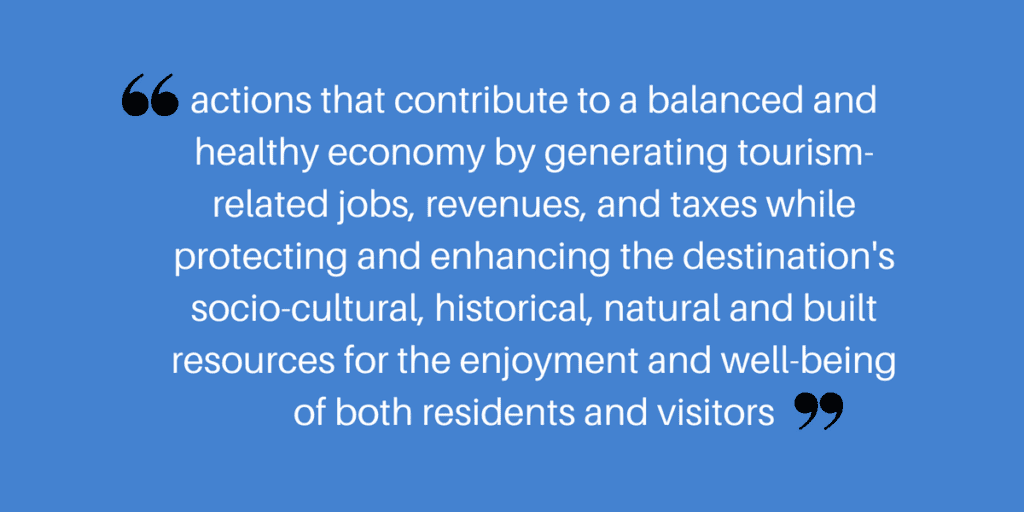 As travelers, we continually crave the next special experience and tourism continues to expand globally. Our drive to discover what is beyond our own borders makes sustainability more than just a buzzword. It’s a concept vital to exploring remarkable landscapes of the world and interacting with cultures different than our own. These are the very reasons we travel in the first place. Without sustainability in tourism, the unique environments that we seek run the risk of being overused or completely destroyed. Distinctive cultures can lose their identity and become homogenized. To protect against these consequences, responsible travel companies actively manage their impact on the places and people they visit with sustainability initiatives.
As travelers, we continually crave the next special experience and tourism continues to expand globally. Our drive to discover what is beyond our own borders makes sustainability more than just a buzzword. It’s a concept vital to exploring remarkable landscapes of the world and interacting with cultures different than our own. These are the very reasons we travel in the first place. Without sustainability in tourism, the unique environments that we seek run the risk of being overused or completely destroyed. Distinctive cultures can lose their identity and become homogenized. To protect against these consequences, responsible travel companies actively manage their impact on the places and people they visit with sustainability initiatives.
Before we discuss individual examples, let’s understand what sustainability in tourism means. The Center for Sustainable Tourism at East Carolina University defines sustainability in tourism as:

The 4Cs of Sustainability in Tourism
Sustainability initiatives may reach in many directions but most can be categorized as one of the 4Cs: Conservation, Community, Culture, and Commerce. Here are some of the ways travel organizations support sustainability in tourism through the 4Cs.
Conservation
 Conservation is one of the most recognized forms of sustainability practices and probably the most widely adopted. Although conservation takes many forms.
Conservation is one of the most recognized forms of sustainability practices and probably the most widely adopted. Although conservation takes many forms.
- Air New Zealand participated in a native reforestation program in the Hawke’s Bay ecosystem.
- The Caribbean Tourism Organization designed an energy efficiency program for Caribbean hotels.
- Cape Town, South Africa averted “Day Zero” by reducing water consumption by nearly 43% in just the last three years.
- Thailand implements seasonal four-month beach closures in the Andaman Sea to give the surrounding biodiversity an opportunity to recuperate after over tourism.
Other conservation initiatives include wildlife conservation, using solar energy, and waste management programs to reduce, reuse, and recycle garbage.
Community
 The community aspect of sustainability in tourism is often unseen by travelers but takes place within the local society. Non-governmental organizations (NGOs), tour operators, and local hotels create programs to educate local residents and empower them with skills training that helps their community thrive.
The community aspect of sustainability in tourism is often unseen by travelers but takes place within the local society. Non-governmental organizations (NGOs), tour operators, and local hotels create programs to educate local residents and empower them with skills training that helps their community thrive.
- Micato makes a One for One Commitment to send one child to school with every safari sold.
- MCS Cruises created a foundation that helps fight poverty in Haiti.
- Tryall Club in Jamaica has operated the non-profit Tryall Foundation since the 1960s. Its considerable education and health programs include preschool literacy programs, nutrition programs, teacher training, and scholarships for high school and university students.
Culture
 The preservation of indigenous culture is important historically, and experiencing the local customs and traditions are often central to why people visit a certain place. Without taking measures to protect and sustain native practices and folklore, the very elements that make us curious about a destination are at risk of being eroded.
The preservation of indigenous culture is important historically, and experiencing the local customs and traditions are often central to why people visit a certain place. Without taking measures to protect and sustain native practices and folklore, the very elements that make us curious about a destination are at risk of being eroded.
- The European Commission declared 2018 as the European Year of Cultural Heritage because they recognize that culture nourishes tourism while tourism is the means to preserve, appraise and experience culture.
- The Polynesian Cultural Center on Oahu showcases six unique island cultures and is consistently Hawaii’s top paid attraction.
- UNESCO World Heritage Sites across the globe serve to give visitors meaningful access to culturally significant monuments of the past while they help conserve the sites for future visitors.
Commerce
 Optimizing economic benefits in local communities is the fourth pillar of successful sustainability in tourism. Tourism must contribute to the local economy and support business opportunities for residents.
Optimizing economic benefits in local communities is the fourth pillar of successful sustainability in tourism. Tourism must contribute to the local economy and support business opportunities for residents.
- Peregrine Adventures, touted as the world’s most sustainable cruise operator locally sources 90 percent of the food used on its charters, which supports the economies of the small ports it visits.
- Jicaro Island Ecolodge in Nicaragua hires staff and purchases food locally. They also use local artisans to make all of the furniture at the resort from naturally-felled trees which provides more local jobs.
- Rivers Fiji, an ecotourism whitewater rafting tour operator in Fiji, provides employment for rural highland communities who are not part of the typical sun and sea tourism of Fiji. They hire drivers, mechanics, guides, cooks, and administrative management, creating a sustainable tourism model.
How YOU Can Contribute to Sustainability in Tourism
As a traveler, you have choices of what tour operators, hotels, and airlines you use. Don’t hesitate to ask how the travel companies you are considering contribute to sustainability in tourism. The only way we can keep visiting wonderful places is by conserving natural wonders, protecting unique cultural heritage, and supporting local communities. By choosing travel companies who are making a difference, you are also making a difference.
For more information on sustainable travel companies, contact the travel experts at Covington.







Leave a Reply